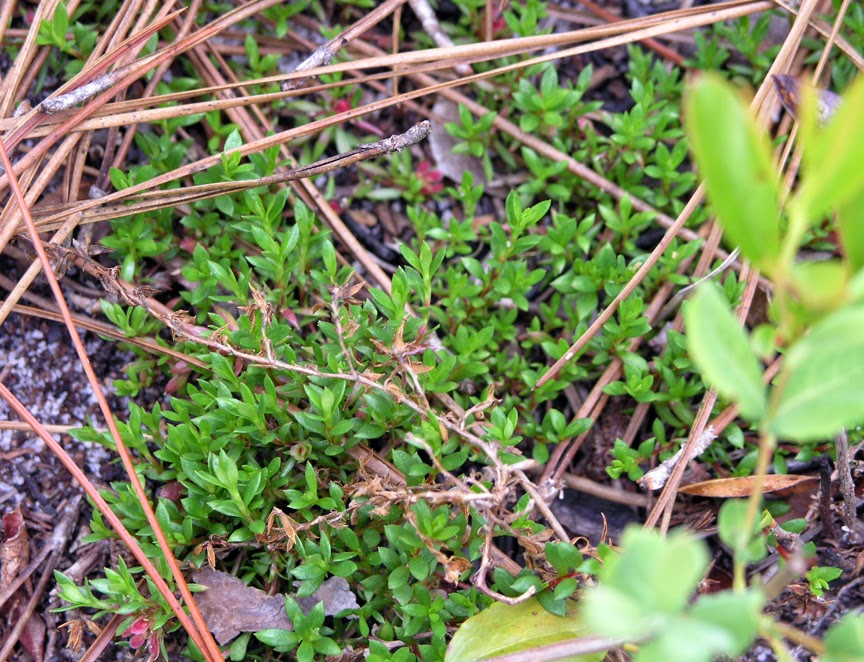While most vegetable gardeners are currently celebrating the season's bounty, this year I'm still digging up holes for trees and flower beds in mid-August. My rocky soil makes for harder work than I'd ever imagined, but this summer's cool weather and well-timed rains have been a real boon. Herb removed the stakes from the trees we planted our first fall here, and with almost two year's worth of growth the front is finally starting to look a little fuller.
 |
| The front garden. |
 |
| By the garage. |
The area by the garage looks better now that the bed has been expanded to include two small hollies, lavender and other perennials. I love the red barberry bush with the yellow leaf edges. To think I almost pulled it out this spring believing it had perished during the harsh winter! Good thing I noticed the roots were alive when I started to dig it up.
There's a lot more work to be done in adjacent areas, not to mention the entire empty back yard. With three new roses on order for fall, I started digging up a new bed behind the three pink bush roses I put in last fall. Two tea roses and a red 'Simplicity' will need lots of tilling and soil amendment for their new home. I wonder how many buckets of rocks I'll have to dig up?
 |
| Coreopsis and blue salvia. |
The flowers I put in last year on the west side of the house are flourishing, so I added three 'Sky Pencil' hollies (Ilex crenata) between the ink berry bushes for more greenery. Somehow, we started referring to the row of arbor vitae out back that divide our property from the neighbors' as "The Ten Little Indians," after the wonderful Agatha Christie mystery I so loved as a girl. These were pathetically small and neglected when we moved in, not to mention numerically wrong--in landscaping as well as art, groupings of even numbers are a particular no-no unless one is dealing with formal elements.
 |
| The Ten Little Indians. |
After two seasons of tender ministration the Ten Little Indians are starting to show marked improvement--this fall I'd like to add one more tree to take the curse off the even numbers. Last year I added a few perennials in front of the row, and this spring the bed was expanded further with some Japanese hollies and a prized variegated boxwood variety called 'Elegantissima' that I got at discount from Virginia Boxwood Co. after working at their booth during the Arboretum's Mother's Day plant sale. I learned so much about boxwood in one day! A particularly attractive plant for this area, deer don't find it palatable and leave it alone.
 | |
| Small boxwood 'Elegantissima' (with whitish leaves) and Japanese hollies. |
The east side of the house presents a bigger challenge, because of the bay windows, the steep hill and utility lines buried underground. Every time I want to dig I have to call Miss Utility to mark the lines so as to stay away from them. But I managed to get in a few more plants in early summer. A taller holly, perhaps a Nellie Stevens, might be good to mask the downspout and unsightly pipes here, though that will make it necessary to eventually move the smaller plants in front. Oh well, it's a work in progress.
 |
| Gaillardias and a dahlia with flame azalea and viburnum. |
 |
| Hydrangeas and False Holly under Herb's office window. |
My latest acquisition was this Japanese false holly (Osmanthus heterophyllus 'Goshiki') planted under Herb's office window to grow between the two hydrangea cuttings I brought from our old home in Columbia. There our hydrangeas were nearly eight foot high and their blossoms a beautiful sky-blue, indicating an acidic soil. Here, the lace-cap hydrangea (on the right) has not bloomed to date, but the re-blooming variety on the left has pink blossoms, a sign that this soil is quite alkaline. The soil acidifier I mixed in does not seem to have had any effect yet.
 |
| Redbud and Dogwood saplings. |
Next: what to do with the empty expanse of back yard? Last year I planted these saplings at the edge of the slope, and they have been making progress (I fear the deer will take their toll, as they did last year, unless I install another electronic deer repellent). Perhaps a water feature as a focal point, maybe a waterfall with a stream? A pond or bog? It's fun to have so much space to deal with!

















































